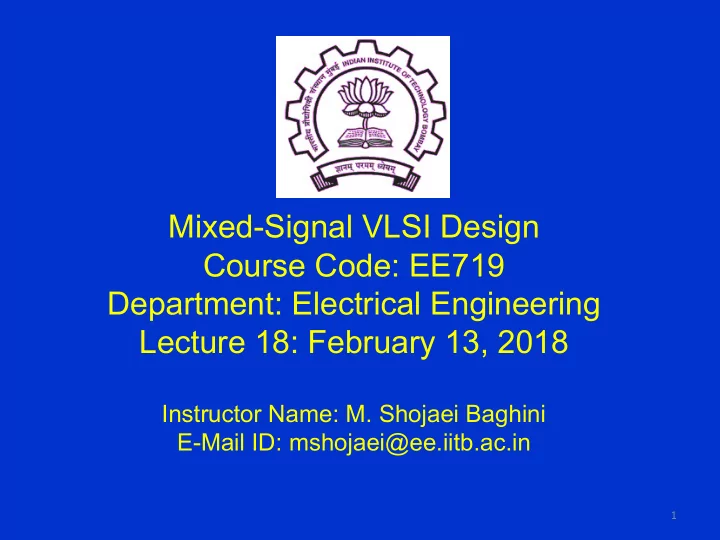

Mixed-Signal VLSI Design Course Code: EE719 Department: Electrical Engineering Lecture 18: February 13, 2018 Instructor Name: M. Shojaei Baghini E-Mail ID: mshojaei@ee.iitb.ac.in 1
2 2 Module 23 Performance Parameters of Data Converters – Part I Reference • Understanding Data Converters, TI, 1995. IIT-Bombay Lecture 18 M. Shojaei Baghini
3 3 Bridge Between Analog and Digital Domains A/D Conditioning Conversion Analog Digital Domain Domain Smoothing D/A and Conversion Equalization IIT-Bombay Lecture 18 M. Shojaei Baghini
4 4 Basic Metrics to Start with l Full Scale Range l Resolution: Effective Number of Bits (ENOB) l Introduced Noise and Distortion: Signal to Noise and Distortion Ratio l Signal Bandwidth l Sampling Frequency IIT-Bombay Lecture 18 M. Shojaei Baghini
5 5 Signal-to-Noise and Distortion Ratio (SNDR) Assume N-point FFT of a sine wave test. If the fundamental frequency is in bin m and has amplitude A m then SNDR is given by the following relation. IIT-Bombay Lecture 18 M. Shojaei Baghini
6 6 SFDR - Example Noise floor Source: Nicolas Gray, National Semiconductor, 2006 Note: The average value of the noise contained in each frequency bin of M-point FFT is 10 ´ log (M/2) dB below the total noise power. IIT-Bombay Lecture 18 M. Shojaei Baghini
7 7 Spurious-Free Dynamic Range (SFDR) l In general dynamic range is the ratio of largest absolute value of the signal to the smallest absolute value of the signal. l Spurious-free dynamic range (SFDR) is ratio of the input signal to the peak harmonic (or spurious) component. IIT-Bombay Lecture 18 M. Shojaei Baghini
8 8 Intermodulation Distortion (IMD) l Most of signals contain many frequency components. l Non-linearity causes two or more signal frequencies to produce intermodulation products. Single tone SFDR Multi tone SFDR Source: Analog Devices tutorial MT-053, 2009 Frequency Frequency IIT-Bombay Lecture 18 M. Shojaei Baghini
9 9 Ideal Characteristics of DAC/ADC D : LSB size Starting from DAC ?@A 123_567 = ∆ : 𝑐 < ×2 < 𝑊 DAC (I) <BC Type equation here. b i : bit # i Center point • Analog input range 1 LSB May be [-V FS /2,V FS /2]. ADC (II) Signed output code • may be used. IIT-Bombay Lecture 18 M. Shojaei Baghini
10 10 Quantization Error in Ideal ADC q e (t) … … t Example: N=6 bits Þ SNR=37.9dB N=10 bits Þ SNR=62.0dB 2 D 2 V K 2 = = q FS ( ) 𝑓 F 𝑞 𝑓, 𝑢 𝑒𝑓 = D e 2 12 ´ N 2 12 @K For a sinusoidal signal V = x FS x(t) and approximate rms 2 2 ∆/F ∆ 𝑒𝑓 = ∆ F 𝑓 F 1 uniform distribution of q e . D æ ö 2 x 12 ç ÷ = = + SQNR 10 log rms 6 . 02 N 1 . 76 dB @∆/F ç ÷ 2 q è ø e IIT-Bombay Lecture 18 M. Shojaei Baghini
11 11 End of Lecture 18 IIT-Bombay Lecture 18 M. Shojaei Baghini
Recommend
More recommend